Editor’s note: This text-based course is an edited transcript of the webinar, Helping Children Learn Through Bias-Free Observation and Assessment, presented by Rebecca Reynolds, EdD.
Learning Outcomes
After this course, participants will be able to:
- identify and describe non-biased documentation of assessment.
- differentiate internal perspective on student testing and assessment.
- reframe characteristics of non-biased assessment.
Introduction and Agenda
My students call me Dr. Rebecca. I've had the pleasure of teaching every level of education from the infant room in Head Start, preschool, grade school through high school college and now graduate and postgraduate school. I can honestly say that education is my passion. I do have a favorite age group even though favorites in the field of education are not supposed to happen, they often do. I have several working titles. I'm a Program Director for an international organization called International Preschool Curriculum where I oversee the training of teachers all over the world. I now oversee other trainers who I have trained to assist me in assuring the education of early childhood classroom teachers. I am also adjunct college faculty at various colleges and work with several international schools to rebuild schools with system breakdown or failure to help them regain their establishment. I love what I do. I firmly believe that if you wake up and have to go to work and do not love your work, you really should find another career option. With this said, I find it feasible to assume that how a teacher feels while in the classroom can and will impact how the teacher can be influenced by bias. After all, teachers are human too and bias happens to everyone. Together, we will cut into the topic of bias and how this bias impacts how teachers document their observations and assessments. In the end, I hope to have given you a few new teaching tools to help you prevent bias and the issues that bias can create. The agenda we will follow in this course includes:
- Vocabulary
- Learning Outcomes
- Formative & Summative Assessments
- Subjective & Objective Observation
- Identifying bias recorded in observation
- Documenting & Avoiding Bias in Observational Assessment
- Practice
- Conclusion with Application of the NAEYC #EquityinECE
Vocabulary
- Learning Outcomes/Objectives
- Formative Assessments
- Summative Assessments
- Subjective Observation
- Objective (Facts) Observation
- Bias
- Advancing Equity = non-biased = everyone is equal = A GOAL OF NAEYC!
- Jean Piaget (learned by observing)
- Differentiate
Each listed item here is important information for teachers to fully understand any possible impact bias can have on assessment and the documentation of that bias. Each vocabulary item listed will be defined and practiced in this presentation. To touch base on some details, learning outcomes will be compared to learning objectives. Formative and summative assessments will be defined, subjective and objective observations will be explained, compared and practiced and differentiation will be defined and practiced. Then NAEYC's advancing equity will be explained as it applies to the conclusion of this presentation.
As for Jean Piaget, he is mentioned here as the beginner of the objective observation model. Piaget observed his own three boys and applied what he learned through observation to many of the beginning building blocks of the early childhood facts we know and work with today. Piaget's history is a fascinating one. By observing his own children, Piaget coined and defined several very useful terms known and used in today's world of early childhood and psychology.
For every new lesson, there are possible outcomes. The learning outcomes for you as the participant in this course include the ability to identify non-biased documentation. In addition, the ability to differentiate will be assisted by separating actual observation and opinion. Then you can take your opinions and reframe and support your observations. Breaking this down into steps can help to alleviate any worries but will still take some real consideration and practice.
Identify Non-Biased Documentation
When thinking about bias, we need to be careful about the words we use when recording observations. The words we use need to be chosen very carefully. Here are sentences that you may find located in an observational notebook. Read each sentence and identify which observations contain bias and which do not.
- Lori cannot cut in a straight line.
- Lori doesn’t want to cut.
- Lori put her thumb into the scissor hole where the finger belongs and the finger in the hole meant for the thumb.
1. Lori cannot cut in a straight line. Is this biased? Yes or no?
The answer is yes, this sentence is biased. When recording your observation, what you write needs to be exactly what you see and hear. The word "cannot" is not visually or auditorially recognizable. Instead, you can write what you see her doing and hear her saying. You can write, Lori held the scissors with her finger and thumb over small holes. Lori picked up the paper and placed it into the scissors. Lori shut the scissors on the paper. The paper then bent instead of being cut.
2. Lori doesn't want to cut. Is this biased? Yes or no? And why?
Yes, this sentence is biased because it gives only your opinion about what Lori wants. Instead, write exactly what you see and hear. For example, you can say, Lori put the scissors down and put her head down on the desk.
3. Lori put her thumb into the scissor hole where the finger belongs and the finger in the thumb hole meant for the thumb. Is this biased? Yes or no? Why?
No, this is not considered biased. This is a completely non-biased observation and is ready to be used for assessment because there are no opinion statements in this sentence.
Differentiate & Produce Internal Perspective of Student Assessment
Differentiation or to differentiate simply stated means to educate to individual needs of each child or group of children. Even though it may seem impossible timewise to differentiate, it will be a challenge at the beginning of each new year or with each new child. As time goes on, your days will become easier with more children reaching your planned objectives. It is because of this that differentiation is highly suggested.
There are several options for how to find ways to differentiate. Each of these options requires the same beginnings. Those beginnings include:
- Understanding child development
- Getting to know the children in your class
- Being organized and taking an internal perspective
- Asking a few questions to begin
- Who needs to have differentiation?
- How can I best use differentiation?
- Should I consider learning styles while differentiating or only learning needs?
- Should I consider both learning styles and learning needs?
My best suggestion is to use both learning styles and learning needs. This is actually easier than you think. Once you develop your own working system for differentiation, your teaching will include less planning time, less assessment, and give you more time to be with your kids in your room. In a good majority of early childhood classes, much of the teaching is done through learning stations or centers. This makes differentiation towards learning styles pretty easy. For example, a musical learner will enjoy headphones with songs related to the topics being taught in the current lesson. For your bookworms, add a few books to your children's library about the current topic. For your artists make sure to have items like glue, scissors, and other materials and items that will encourage the children to stay on topic while creating their own interpretation of the topic.
Differentiation to meet the needs of different types of learners is the fun part. However, it may be a challenge to differentiate and meet the needs of children with disabilities. You should have documentation to assist in guiding you in what their educational need consists of. For example, a wheelchair-bound student can't run but that child may be able to use the wheels to move the chair independently. Or perhaps you have a child who can't stand in line without pushing. Differentiation for this child could consist of labeling this child as a classroom helper or giving this child the items needed to carry while in line moving to the next activity. Possibly this child can carry your clipboard or your first aid kit. By giving this child a responsibility to concentrate on, you can help them think about the responsibility rather than their own sensory stimulation.
Reframe & Support Characteristics of Non-biased Assessment
Reasons for Bias
- Racial differences
- Income levels
- Personal preferences
- Dislike of parents
- Student(s) are slow
There are many reasons for bias. For example, perhaps identifying another race is difficult because all you grew up with were people of the same skin color as yourself. Perhaps at a young age, you overheard your parents talk badly about other people who were different than yourself. Racial differences should encourage you to find the similarities that we have instead of looking for the differences. But as we all know, human nature does not always do the right thing. Racial bias is more than likely a learned idea from childhood whether we know it or not.
Bias can come from many areas of thought. Perhaps you're jealous of others who have more materialistic items than you. Perhaps they earn more money. Or we could look at the other side of it. Perhaps understanding for a family who has no money to wash their clothes on a regular basis is a challenge. After all, how can they not prioritize the fact that their children are the smelly ones in class? This bias, dislike for others due to their income level, can stem from beliefs in the childhood home or even from watching others in your teenage years.
As you can see, there can be many reasons for bias. As teachers, we need to ensure that our own biases do not create hostility, dislike, or other negative features that can intrude on the classroom and assessment. When we assess we need to support non-biased assessments. This includes making sure that our own bias does not end up in writing while you are documenting observational assessments. Of course, this is going to be a challenge.
Support Non-Biased Assessment
- Understand that all races are equal
- Use income level information to HELP children in need
- Learn the personal preferences of children in care
- Try to work WITH parents
- Differentiate for each student’s needs
Supporting a non-biased assessment includes the understanding that every race is the same. We are all the human race, no matter our skin, hair, or eye color. Things like our abilities and intelligence levels do not differ between people because of their skin color or race.
As for those who provide you information about their income level, use this information to help the children in your care. For example, if you know the child is struggling with reading and you have been informed that this family is financially set, suggest a tutoring service. Or on the other hand, if you see a child who needs help with math who you know is unable to afford tutoring services, locate local resources for that family. For example, libraries and organizations like Big Brothers and the YMCA. At times these organizations will offer free tutoring for those in need.
Be sure to figure out the children's needs and preferences above your own. If the children are old enough, you can discuss with the children what their preferences include. This may be as simple as asking a crying child if he wants a hug. If he says yes, give him a hug. If he says no, let him know that you are available in case he changes his mind, then make sure to be available.
Include the parents when assessing children. Including the parents can help the children be more comfortable and less stressed out. Observational assessment should not be a stressful assessment format. If the teacher is stressed or the children are stressed, an assessment will not come out accurately.
Last but truly not least, differentiate as much as possible. For example, if you have a child with ADD who struggles to stay in his seat, think about using alternative seating such as a rocking chair, a stool, or perhaps a beanbag. If you spend time figuring out what type of seating this child will be most comfortable in, you are more likely to have a better assessment result than if you give him the typical hard seat he squirms in.
Reframing and supporting characteristics of non-biased assessment is not an easy feat. To summarize, reasons for bias include racial differences, income levels, personal preferences, dislike of parents, and students are slow. You need to understand that all races are equal. Use income level information to help the children in need. Learn the personal preferences of the children in your care and try to work with the parents. Differentiate for each student's needs. As said before, this can be a challenge at the beginning of the class or when a new child comes into the classroom. However, you will find that it is worth the effort.
Learning Outcomes - Assessing Children
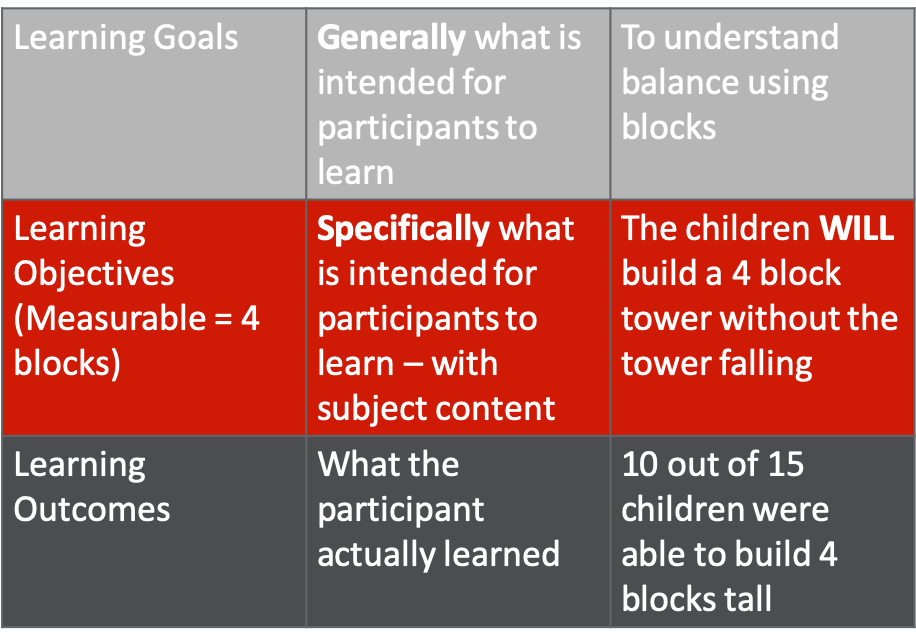
Figure 1. Learning Goals/Objectives/Outcomes.
There is a difference between learning goals, learning objectives, and learning outcomes as seen in figure 1. Learning goals include a general description of what is intended for the participants to learn. For example, you could state a learning goal for young children playing with blocks is to understand balance while using blocks. You can see that this is a general statement. Learning objectives are measurable. They have a slightly different explanation as stated in the learning goals. Remember, the learning goals are general and the objectives are measurable. A learning objective is specific. An example of a learning objective might be: the children will build a four-block tower without the tower falling. This specific difference with the objective versus the goal is the measurement included. By stating that the objective is to build a tower of four blocks, you are giving a way to measure and assess a possible outcome. Written learning objectives are the pathway to learning outcomes. Unlike learning goals and objectives, learning outcomes include what is identified and measured after the planned activity. The information gleaned from the learning outcomes is what teachers document in the children's assessments. Did the children reach the objective? Did the children work at reaching the objective but could use more practice? etc.
As stated before, the learning objective is a pathway towards the learning outcome. By including measurement and the learning objective, you can compare the numerical measurement with a measurement in the completed outcome of each child's learning. Learning outcomes include what is identified and measured after the planned activity. The information gleaned from the learning outcomes is what teachers document in the children's assessment and portfolios. In the documentation, you can answer questions such as:
- Did the children reach the objective?
- Did the children work at reaching the objective but could use more practice?

Figure 2. Example of Learning Goal/Objective.
Take a look at the example in figure 2. Lori will cut in a straight line is a learning goal. By simply adding a measurement here, this learning goal can be changed into a learning objective. That objective applied to a lesson or learning plan has an outcome as soon as the activity is completed. That outcome answers at least one of these questions:
- What has the child learned?
- How much has the child learned?
- What can I put into the plan that will encourage further learning?
This system should be a constant in the teacher's daily routine for every child. When done with the cycle, your observations would show a progression towards completed learning objectives.
Formative and Summative Assessments
By asking the previous questions, you can begin an assessment of each child. There are many formats of assessments. I typically find two types of assessments used in the early childhood classroom; formative assessment and summative assessment. Both formative and summative assessments can assist in planning and assessing.
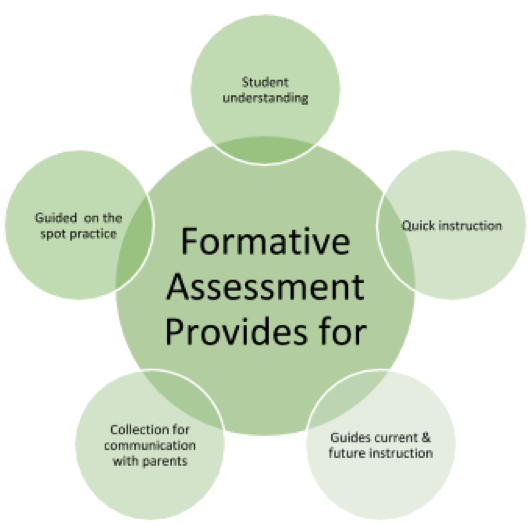
Figure 3. Formative Assessment.
Formative assessment is an assessment with two ideas. The first is that this assessment is done on the spot and not always recorded. The second idea of the formative assessment is to gauge student's learning during an activity in order to change or tweak the presentation format of the current topic to match each child's immediate needs. This can be used to guide each student by adjusting your lesson as needed, to check for further understanding, and of course, to give an idea of how to structure future lessons. Taking the formative assessment format, this teacher can verbally ask a group playing Shape Bingo, "How can you tell the difference between a square and a rectangle?" Typically, at least one person in the group will answer correctly. If Samantha is listening, she may simply change her pieces without being prompted.
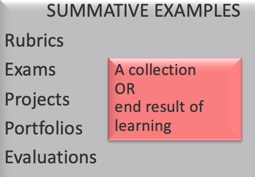
Figure 4. Summative Assessment.
Summative assessment takes a collection of material produced by each child, typically taken and organized in chronological order to show growth. This can be used to present work and growth to parents, other educators and administrators, and it can be used to plan long term goals. For example, a teacher during a small group activity at a table has planned a game of Shape Bingo. During this game, Samantha's bingo chips are placed on all of her rectangles. However, the teacher called out two rectangles and two squares. The teacher observes that Samantha understands that both shapes have four sides because Samantha is counting the sides of the shapes before she puts her chips down. This tells the teacher that Samantha may not understand that a rectangle has two sides longer than the other two sides. Taking the summative assessment format, this teacher can plan individual time with Samantha. The teacher can lay out more shape activities in the learning centers of the classroom to give Samantha more time to interact with the shapes for self-learning. This teacher can also assist by creating a partnership with another student who understands the shapes. Then by taking work samples, pictures, etc. of Samantha's work, a measurement of growth in the area of shape recognition can be made to assess Samantha's progress.
Observation as Assessment
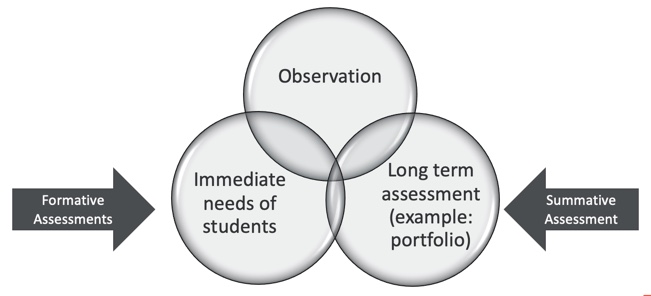
Figure 5. Connections between Observation and Assessment.
There can be an overlap of each assessment format as is seen in figure 5. Different assessment formats can complement each other. Once practice with each format has been accomplished as described in the observation of Samantha, we can think about observation as a form of assessment. As demonstrated here and described previously, formative assessment leads to solving the immediate needs of students and summative assessment can best serve in long-term assessment and planning. If formative assessment is documented as small narratives, the teachers can use this and place this with the summative assessments and use the formative assessments to help create a timeline of growth. The biggest and most prevalent connection between both forms of assessment is observation. This creates a real use for observation as a tool.
Subjective and Objective Observation
Now that we have established a few real uses for observational assessment, let's establish a format to follow when observing to prevent as much bias as possible. The first thing to understand is how to document your observations, including documenting exactly what you see and hear. This means not to include any bias or opinions written into these observations. Objective observation equals just the facts.
A good example of this is:
Kimber put her sweater on her right arm first, then her left arm got caught in the hole where the head goes into. Kimber then asked the teacher for help.
This is a non-biased observation because there are no opinion words written. This is also a good example of an objective observation because it gives the exact details of what happened without opinion.
Then after you've written the objective observation, take the time to write your subjective observation. A subjective observation includes your opinions and assessments. Using the same example:
Kimber showed determination and patience while trying to put her sweater on. She didn't get upset. This demonstrates that Kimberly's emotional control is age-appropriate.
Let's Practice - Subjective or Objective
Is it subjective or objective? Let's practice. Read the sentences below and identify if each sentence is objective or subjective.
- Stephanie loved to hug her dolls.
- Doni stayed in the block corner building with little blocks.
- Samantha colored out of the lines after the teacher told her it is OK to do so.
- Sandra screamed because she wanted to play also.
- Lori stayed quiet and didn’t talk to anyone.
- John likes it when the music is on.
- Emanuel plays too many video games at home.
Now I will read them again with the answers.
- Stephanie loved to hug her dolls. Writing what a child loves instead of what you see and hear makes this a subjective statement.
- Doni stayed in the block corner building with little blocks. Writing exactly what you see and hear makes this an objective statement.
- Samantha colored out of the lines after the teacher told her it is OK to do so. Writing exactly what you see and hear makes this an objective statement.
- Sandra screamed because she wanted to play also. Writing "because she wanted" instead of exactly what you see and hear makes this a subjective statement.
- Lori stayed quiet and didn't talk to anyone. Explaining what you see and hear makes this an objective statement.
- John likes it when the music is on. Explaining what a child likes instead of exactly what you see and hear makes this a subjective statement.
- Emmanuel plays too many video games at home. Stating "too many" instead of exactly what you see and hear makes this a subjective statement.
Identifying bias recording of observation - Why should we watch out for bias?
Bias Comes in Many Forms
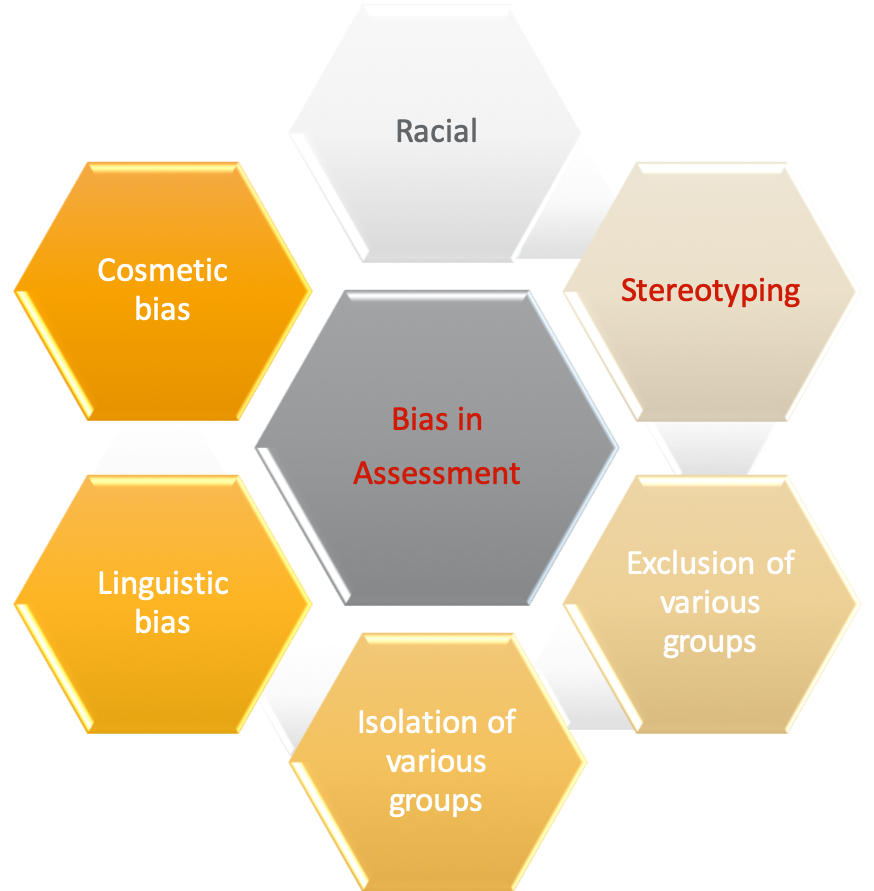
Figure 6. Bias in Many Forms.
FIgure 6 shows examples of bias seen inside and outside of the classroom. Racial bias is one of them. There will be times you'll hear someone deny having a racial bias but as you observe that person, you see them calling on Hispanic children a lot less than other children in the classroom. This is a great example of someone in denial that has a bias that influences their classroom.
Stereotyping can also influence bias. In the classroom, for example, the Asian population has a stereotype of being good with math. When observing a classroom, you will notice that during reading no Asian children are being called on but the same Asian children are the only ones being called on for math. This type of bias can lead to a self-fulfilling prophecy. By giving only the Asian children math experiences, the teacher is essentially only teaching the Asian population math and negating their ability to read.
Cosmetic bias can include fearful behavior towards another person because they look different. This can include skin color, deformities, thick glasses, or anything that is different from what a person is used to seeing. As you can see from figure 6, there are many types of bias, each one influencing the classroom. Even though educators or children may not be aware of it, teachers must set a good example of integration, patience, and tolerance. By teachers watching themselves and being aware of their own biases, teachers can begin to set a good example for the children to follow.
Don't be afraid to answer questions from the children about bias. It is recommended to address their questions with as little bias as possible. Be sure to listen to their worries and be prepared to ask other professionals when you feel support is needed.
Documenting and Avoiding Bias in Observational Assessment
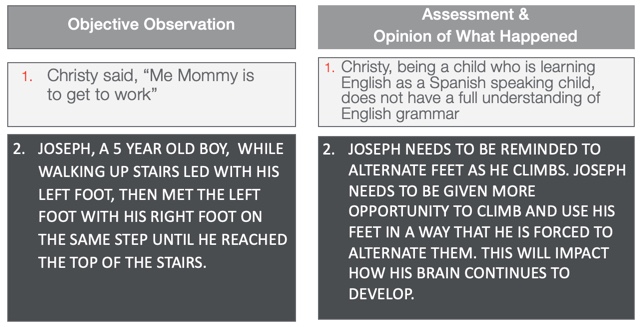
Figure 7. Examples of Documenting and Avoiding Bias.
Figure 7 shows examples of documenting and avoiding bias in observational assessment. The left side shows the objective observation and the right side shows your assessment and opinion of what happened or your subjective observation. The first example is about Christy. Christy said, "Me Mommy is to get to work." The assessment of this observation is that Christy, being a child who is learning English as a Spanish speaking child, does not have have a full understanding of English grammar.
The second example is about Joseph, a five-year-old boy. Joseph, while walking up stairs led with his left foot, then met the left foot with his right foot on the same step until he reached the top of the stairs. The assessment of this observation is that Joseph needs to be reminded to alternate feet as he climbs. Joseph needs to be given more opportunity to climb and use his feet in a way that he is forced to alternate them. This will impact how his brain continues to develop. Even though Joseph could have been struggling emotionally, it was not written about in the objective observation portion since the objective of this observation was to record Joseph's physical development. By highlighting something that will assist Joseph in the assessment portion, the observer is helping to guide curriculum planning with assessment feedback.
Bias-Free Observation Cycle
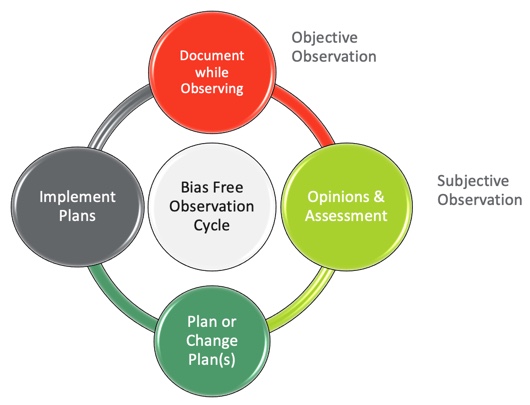
Figure 8. Bias-Free Observation Cycle.
The format of a cycle, as seen in figure 8, helps to create habits that will become easier as time moves on. For example, taking the time to sit and observe children will also allow the children to begin to feel safe with you watching them play. Be sure to expect the children to begin engaging in conversation as you sit. This is okay because you can make this conversation part of the observation. At first, the children may also watch you as they play. Once they are used to your presence, this will become less and less noticeable. Once the observer has documented everything, as it was seen and heard, create the objective observation. This is a paragraph containing any assessments and opinions about the observation. This should be written fairly quickly. If you take the time to write it immediately following your observation, this will help prevent the loss of information. This written exercise of assessments and opinions is the subjective observation.
Once the subjective observation is complete, the information gleaned can help to create or to change any plans to better assist your students. Then as the plans are being implemented, for example, used in class, observation can start again. Watching children grow in this way can be very fulfilling and lead to many answers. Figure 8 shows this cycle of observation, assessment, planning, and implementing, then again, observation.
Practice
1. Observation
- Write only what you see. Do NOT include any opinion words.
2. Opinions & Assessment
- Separate your opinions from what your observation is. Write about: What did each child learn? What do the children need help with? Etc.
3. Plan
- Write what your plan is for the child of your observation to help in this child’s development and growth based on your assessment of observation.
When you are writing an observation, you write only what you see and hear. For example, if you are watching two children (Jason and Joshua) who are playing with a bead counter and say that the children are curious, you are writing your opinion into the observation. If this is your opinion and you feel it is important to say the statement, you should include your opinion in the subjective observation instead. In other words, your opinions and assessments should be separate from your actual observation. In your opinions and assessments called subjective observations, make sure to separate your opinions from your objective observation. In your subjective observation, write things like answers to these questions. What did each child learn? Or perhaps, what do the children need help with? What did you learn from this observation? When planning your next lesson, look over your observations, both the objective and the subjective. Then write what your plan for that child will be based on your own observations, opinions, and assessments.
Example Objective Observation:
- Jason and Joshua are sitting next to the bead counter.
- Jason is moving the beads with his fingers.
- Joshua laughs every time Jason moves a bead from one side to the other.
There are no opinion words anywhere in this portion of the observation. Jason and Joshua are sitting next to the bead counter. Jason is moving the beads with his fingers. Joshua laughs every time Jason moves a bead from one side to the other. Reporting exactly what you see and hear makes this an objective observation.
Example Opinions and Subjective Assessment:
- Jason & Joshua like to play together.
- Jason’s fine motor skills are showing improvement.
- Even though Joshua seems happy, he hasn’t said any words or participated in moving the beads.
There are several things that can be gleaned from this observation for your opinions and subjective assessment. You can talk about the fine motor skills of Jason, the social-emotional skills of both children and/or their social interactions. In your subjective observation, you can write any of your own personal thoughts that can contribute to further a complete assessment of the children's abilities. Please make sure to find a way to use the objective observation and the subjective observation and in an impartial way showing clear equity.
Conclusion with Application of the NAEYC #EquityinECE
- Different assessment formats assist in preventing observational bias
- Formative Assessments
- Summative Assessments
- Subjective Observation
- Objective (Facts) Observation
- Non-biased documentation is NO opinion words OR statements in the assessment
- It will take work to recognize and avoid bias
- Differentiation of activities and assessment is important
- Bias comes in many forms
Equity is an important thing to consider when working with children. Unfortunately, not all things in childhood are equal. As educators, it is our responsibility to ensure that assessment is fair, with every child being assessed in a non-biased way, using the same assessment formats for each child. Be sure to keep assessing yourself to prevent your own biases from impacting the children you work with. It will take some time and work to fully understand how your own biases impact each child you work with. There are several different assessment formats that can assist in preventing bias and assessment, including formative assessments, summative assessments, subjective observation, and objective observation.
Non-biased documentation is the same as having absolutely no opinion words or statements in the objective assessment. It will take work to recognize and avoid your own bias, be it verbal or written. Differentiation of activities and assessment is important. Differentiation used correctly can assist in avoiding bias. Bias comes in many forms.
How This Session Fosters #EquityinECE as applied to observational assessment
- All children have the right to equitable learning opportunities that help them achieve their full potential
- Recognize the power and benefits of diversity and inclusivity
- Create a caring, equitable community of engaged learners
- Acknowledge and seek to understand structural inequities and their impact
- Take responsibility for biased actions - even if unintended - and actively work to repair the harm
- Maximize children’s learning in the classroom and at home, especially in academic, social, and emotional development
- Build awareness and understanding of culture, personal beliefs, values, and biases
- Uphold fundamental principles of fairness and justice
- Embrace each child’s unique strengths
- Work to eliminate structural inequities that limit learning opportunities for both young children and the educators who support them
When considering equity, there are a few items that we as educators need to remember. All children have the right to equitable learning opportunities that help them achieve their full potential. We need to recognize the power and benefits of diversity and inclusivity. We need to create a caring, equitable community of engaged learners. We need to acknowledge and seek to understand structural inequities and their impact. We need to take responsibility for biased actions, even if they are unintended, and actively work to repair the harm. We need to maximize children's learning in the classroom and at home, especially in academic, social, and emotional development.
As you look over this list, you will be able to recognize a common thread that we as educators must be the ones to set the example of how to start our communities learning how to be accepting of others, no matter the differences. By building awareness and understanding of culture, personal beliefs, values, and biases, we can fully educate ourselves and the children we serve to unfold fundamental principles of fairness and justice. We must embrace each child's unique strengths and without judgment, help them to develop where they have challenges. We need to work together in eliminating structural inequities that limit learning opportunities for both young children and educators who support them. As educators, we must work together to help our children learn the benefits of non-biased education.
Questions and Answers
What if you are not able to write down an observation immediately after it happens? Do you have any suggestions so that they can remember all of that information and still obtain that observation?
There are several ways that can be done. I've seen teachers without electronics who have written anecdotal notes on post-it notes so that they can remember to put it in their portfolio later. Creative Curriculum has an app for tablets. The teacher carries around a tablet all day and can put a checkmark or write down an observation or take a photograph and immediately it goes into their portfolio electronically. Teachers can also use a tablet or cell phone to take pictures to print and add to a portfolio later. Each teacher's experience is different. It's good for them to experiment with what works best for them. I've seen some teachers use a clipboard. Every classroom typically has a clipboard with a paper with the children's names on it already, so when they go outside or out of the classroom, they use that same clipboard to keep anecdotal notes on the kids.
Could you review the definition of differentiation? What is the ability to differentiate and how people can do that in the classroom as they're working with children?
Differentiation is not new. A lot of teachers have been doing it without realizing it. There are several different methods you can use. Here's an example.
You are sitting at a table with five children doing a small group activity, such as playing a Bingo game. Earlier we had the example of working on shapes. Let's say you're working on the first five letters of the alphabet and you want the children to recognize the lowercase and uppercase letters A, B, C, D, and E. As your learning objective, you're hoping that the children will be able to recognize four out of the five letters, both lowercase and uppercase. That gives it a numerical value for your assessment.
When you're working with the children, you notice that Stephanie is doing great. She has recognized all five letters. She's smiling and her shoulders are up. Then you have Samantha, who's leaning against the table trying not to answer anything. You start observing Samantha because you want to know if she can recognize these letters. Samantha doesn't answer anything. Then you move on and to Doni. Doni does okay and gets three out of five. You make a little note to go back over this with Doni. There's a little bit of observation there. Next is Lori. Just like Stephanie, she does great, gets all five letters, and sits up proudly.
Let's say three out of the five children get all five of the letters. They're all proud of themselves. You can excuse those three out of five children to find another activity or work with another teacher, whatever your classroom plans are for them to do next. You stay at the table with the two children who you see are struggling for some reason.
You start working with Samantha, who is being quiet at this moment. You talk quietly so that you can reach her on her emotional level and she starts to whisper to you but you can't hear her. So you sit closer. With all of these different movements that you're doing, you're differentiating to meet her needs. By excusing the other children, you are eliminating possible distractions. By sitting closer to Samantha, you're giving her the ability to talk quietly because at that moment she obviously needs it. All of these little movements, are you differentiating to meet her needs. Finally, she talks and she tells you, she doesn't know the letters.
Something that's not in your observation or something that you didn't know is that maybe Samantha comes from another country like Russia. The lettering is very different in Russia. The letters don't look the same. That's okay. So you ask Samantha to take a look at what's in front of her and tell her you'll be back with her in a few seconds. Ask your other student Doni who didn't recognize all of the letters and give him a worksheet to practice with or a puzzle of letters to practice with, so that he's not waiting for you. Come back to Samantha and work with her one on one for each letter. Every time she gets one correct have a positive influx in your voice and let her know that you're proud that she's working so hard. As you keep working with her, use all of these different little things to differentiate what you're doing to meet her needs. When you're done working with Samantha, go back to Doni. In the same process that you used with Samantha and through conversation and observation, do the same thing with Doni to find out what he needs and to change your behaviors to differentiate to meet his needs.
Is there anything else that you would like to share regarding bias-free observation and assessment?
One of the most important things is for a teacher to keep self-evaluating. Evaluating yourself just once is not enough. You have to constantly be aware of how your speaking and if you're paying attention to one group more than the other group. It is a constant thing that you need to be aware of. Also, if you find that your own behavior has impacted a child in a negative way, a good way to gain or regain that child's trust is to apologize for it. Not only will you regain trust, but you're setting a good example.
References
Gilliam, W. (2018). Head Start ECLKC - Preschool Expulsions and Suspensions: What Early Childhood Leaders Need to Know about the Role of Implicit Bias. Retrieved from https://eclkc.ohs.acf.hhs.gov/video/preschool-expulsions-suspensions-what-early-childhood-leaders-need-know-about-role-implicit
The Peak Performance Center (n.d.) Learning Goals, Objectives & Outcomes. Retrieved from http://thepeakperformancecenter.com/business/learning/course-design/learning-goals-objectives-outcomes/
Citation
Reynolds, R. (2020). Helping Children Learn Through Bias-Free Observation and Assessment. continued.com - Early Childhood Education, Article 23564. Retrieved from www.continued.com/early-childhood-education
